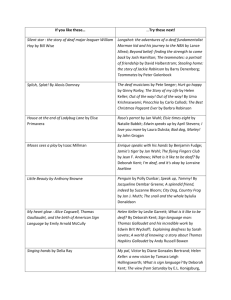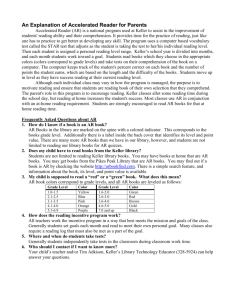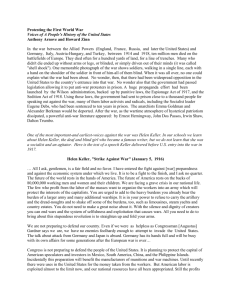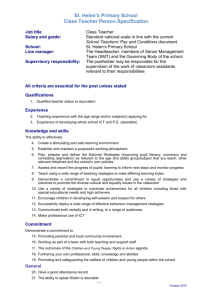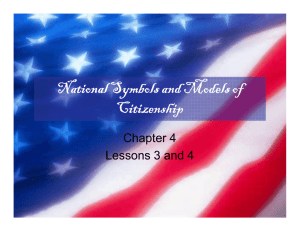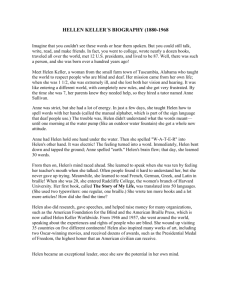People and Moments in Time
advertisement
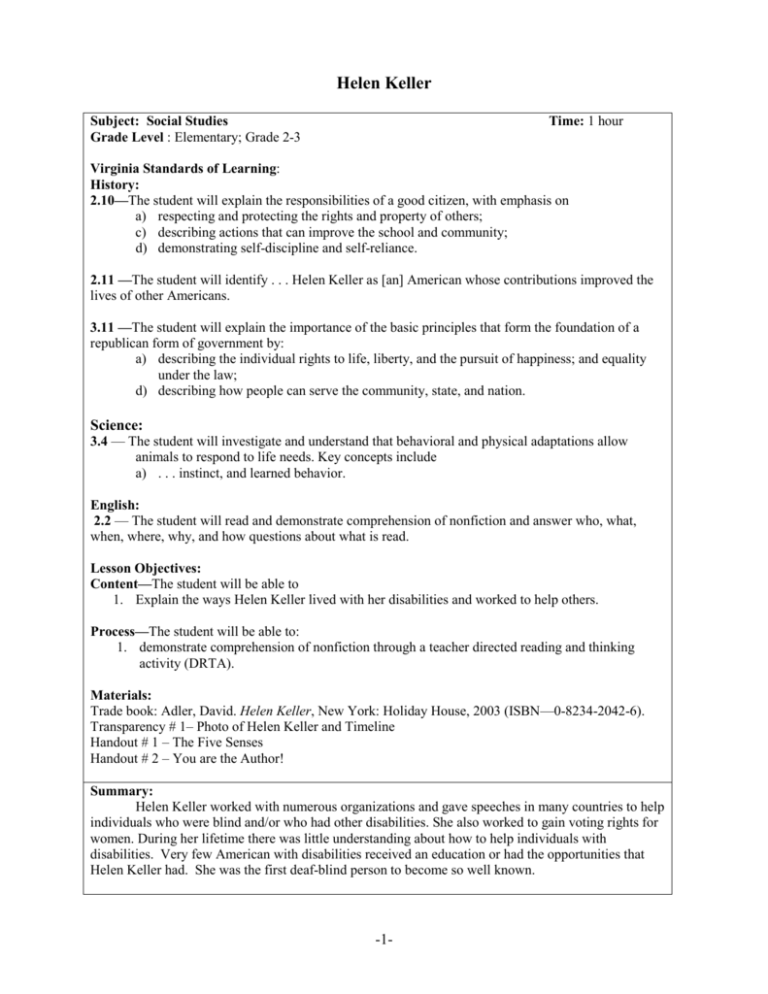
Helen Keller Subject: Social Studies Grade Level : Elementary; Grade 2-3 Time: 1 hour Virginia Standards of Learning: History: 2.10—The student will explain the responsibilities of a good citizen, with emphasis on a) respecting and protecting the rights and property of others; c) describing actions that can improve the school and community; d) demonstrating self-discipline and self-reliance. 2.11 —The student will identify . . . Helen Keller as [an] American whose contributions improved the lives of other Americans. 3.11 —The student will explain the importance of the basic principles that form the foundation of a republican form of government by: a) describing the individual rights to life, liberty, and the pursuit of happiness; and equality under the law; d) describing how people can serve the community, state, and nation. Science: 3.4 — The student will investigate and understand that behavioral and physical adaptations allow animals to respond to life needs. Key concepts include a) . . . instinct, and learned behavior. English: 2.2 — The student will read and demonstrate comprehension of nonfiction and answer who, what, when, where, why, and how questions about what is read. Lesson Objectives: Content—The student will be able to 1. Explain the ways Helen Keller lived with her disabilities and worked to help others. Process—The student will be able to: 1. demonstrate comprehension of nonfiction through a teacher directed reading and thinking activity (DRTA). Materials: Trade book: Adler, David. Helen Keller, New York: Holiday House, 2003 (ISBN—0-8234-2042-6). Transparency # 1– Photo of Helen Keller and Timeline Handout # 1 – The Five Senses Handout # 2 – You are the Author! Summary: Helen Keller worked with numerous organizations and gave speeches in many countries to help individuals who were blind and/or who had other disabilities. She also worked to gain voting rights for women. During her lifetime there was little understanding about how to help individuals with disabilities. Very few American with disabilities received an education or had the opportunities that Helen Keller had. She was the first deaf-blind person to become so well known. -1- Evaluation/Assessment: The student will be assessed: 1. informally for understanding of who, what, when, where, why, and how questions through their participation in class discussions. 2. on the completeness and correctness of responses to Handout #1— The Five Senses. 3. on the completeness and correctness of responses to Handout # 2— You are the Author! Lesson Procedure: Background Knowledge and Purpose Setting: 1. Take several digital pictures around your school building that show accommodations for Americans with disabilities. (curb cuts, Braille signs, ramps, etc.) Display the digital pictures for students or take a short walk around the building. Explain that July 26, 2010 was the 20th anniversary of the Americans with Disabilities Act (ADA) that made these modifications the law. Ask why it is important to have an accessible building. 2. Explain that today students will learn about an American woman who lived long ago (100 years before the ADA was passed). She overcame many challenges and worked to help others gain their rights. Her name is Helen Keller 3. Display Transparency # 1—Photo of Helen Keller. Point out that she is holding a book and smelling a flower. (The class will come back to this picture during closure.) 4. Note the timeline below her picture. Reading/Note-Taking 5. Describe the characteristics of a biography. Explain that learning about real people through biographies can be fun. 6. Explain that students will read a biography of Helen Keller. They will read and take notes on important or interesting facts and details about her life. Model for students how to answer who, what, when, where, why, and how questions about Helen Keller. Explain that once we know the answers to each of these questions we usually have most of the facts. 7. Conduct a shared book experience with Helen Keller, stopping to discuss what has been read after each chapter and making predictions. Confirm or correct any predictions made. Processing Information 8. Write on the board “who, what, when, where, why, and how.” Through a whole class discussion answer these questions in regard Helen Keller’s life and the way she helped others. Reread the story if necessary. 9. Again display Transparency # 1—Photo of Helen Keller. Ask students why she is holding a book and smelling a flower. Explain that one of the important ways she adapted to her disabilities was to use the senses she had. Explain that people, like all living things, use behavioral and physical adaptations to react to life needs. For instance, a physical adaptation is fur on a bear and an example of a behavioral adaptation is the migration of birds. 10. Show a video clip of Helen Keller using her sense of smell and touch to tell who is in a room and what they are saying. Legends, Icons and Superstars of the 20th Century http://www.awesomestories.com/assets/helen-keller-documentary-feature. This links to a video clip on Helen Keller which shows newsreel footage and scenes from movies. 11. Distribute Handout # 1—The Five Senses. Ask the students to read along while you read the instructions and to write their name in the top right box. Model how to complete the chart. When complete, ask student volunteers to read some of their responses. Collect the handout to assess student understanding. Closure: 12. Distribute Handout # 2—You are the Author! Explain to students that Helen Keller was a well know author. Explain that now they will have the opportunity to be an author, too. Model how -2- 13. 14. 15. 16. students will use the words listed to tell about Helen Keller. (i.e. If the words were finger, water and teacher— a sentence could be: “Helen Keller’s teacher helped her understand the finger alphabet by using water.”) Ask volunteers to read their sentences and show their illustration. Explain that during her lifetime there was little understanding about how to help individuals with disabilities. Very few American with disabilities received an education or had the opportunities that Helen Keller had. She was the first deaf-blind person to become so well known. Today the Americans with Disabilities Act protects the rights of Americans with disabilities. It is against the law to keep someone who is blind or who has a disability from getting a good education, using public transportation or getting a job. Helen Keller was a woman with great courage. Sing the song, Helen Keller (sung to the tune of “Yankee Doodle”). Helen Keller Helen Keller was disabled Couldn't hear or see Helen learned to speak and read, Just like you and me. Helen's fingers were her eyes in her special books Rights for all was her main cause, A woman of great courage. Tune: Yankee Doodle Additional Resources: Web-based: 1. American Foundation for the Blind http://www.afb.org/braillebug/hkindex.asp --this site is a media gallery containing a wealth of resources on Helen Keller. 2. Phoenix Learning Group http://www.youtube.com/watch?v=pIaMgD1VmmY a short video clip that shows how Helen Keller using her senses. 3. http://www.youtube.com/watch?v=9byDotOHG3I This is a nice overview of Helen Keller. It is appropriate for elementary students. 4. America's Story-- Library of Congress http://www.americaslibrary.gov/aa/keller/aa_keller_subj.html Print Sources: • Helen Keller by Margaret Davison. New York :Scholastic, 1969 • Helen Keller: A photographic story of a life (DK Biography) by Leslie Garrett DK Publishing New York, 2004. -3- Transparency # 1 Helen Keller reading a Braille book and smelling a rose Source: Library of Congress. -4- Handout # 1 The Five Senses We use our senses to learn about the world around us. We see, hear, smell, taste and touch. Our senses tell our brain that the stove is hot and that candy tastes sweet. When we lose the use of one of our senses we learn to rely on the senses we do have. This is what Helen Keller did. Compare and contrast how you use your senses with Helen Keller. Pair up with another student and write a sentence in each block explaining how each of you uses the sense listed on the left. Circle the senses you have that Helen Keller does not. Put a check mark beside the sense Helen Keller used most often. Sense Helen Keller Your name _________________ Touch Hearing Taste Sight Smell -5- Handout # 2 Name __________________________________ You are the Author! Be an author like Helen Keller. Use at least 6 of the words listed below to describe how Helen Keller helped improve the lives of Americans. After you write your sentences below create an illustration for your work in the box. [teacher, deaf, women, blind, soldiers, rights, Braille, author, speeches] ______________________________________________________ ______________________________________________________ ______________________________________________________ ______________________________________________________ ______________________________________________________ ______________________________________________________ ______________________________________________________ ______________________________________________________ ______________________________________________________ -6-


